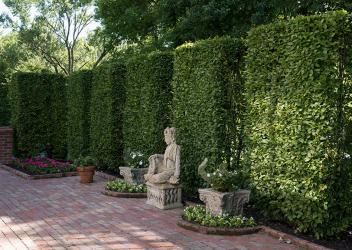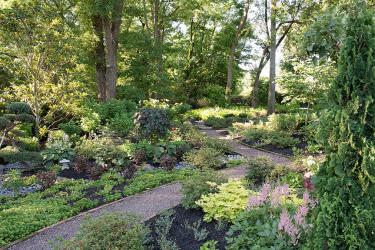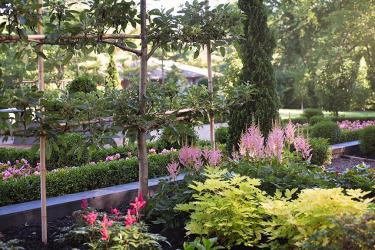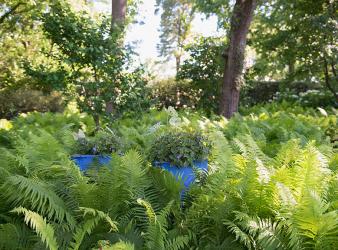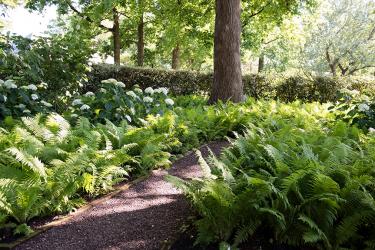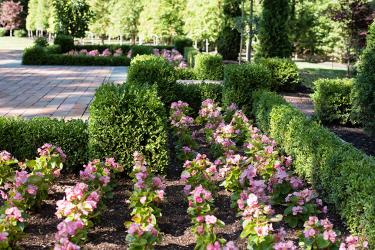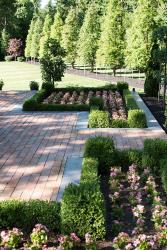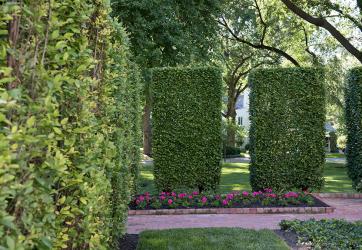In his 70-year career in horticulture, Bob Dingwall hasn’t missed a beat and has always relished a challenge. “I enjoy people telling me I can’t do things,” he says with a bit of a smile. His answer, he relates, always is, “Yes, you can make a plant grow the way you want it to grow.”
Those were exactly the words the homeowner wanted to hear. The homeowner had made contact with Bob through one of Bob’s many happy clients, and he had a precise request for the former chief horticulturist at the Missouri Botanical Garden, who now has his own consulting business.
He wanted a garden that reflected geometric precision. Pictures of a precisely pruned English garden provided some of the inspiration. He also requested an espalier garden with fruit trees growing on a flat, two-dimensional plane and had another, more unusual question.
A line of dawn redwoods had been planted two years previously. Could Bob make the trees that grow to 65 feet in height when left on their own, be trimmed into a Japanese style? I said, “’Yes’, I can do this and, ‘yes,’ I can do that. I just continued to say, ‘yes,’” Bob recalls with a laugh. With the dawn redwoods, it was basically making them bonsai specimens, he explains
Three years, what has to be hundreds of hours of pruning and a flurry of planting later, a stunningly precise garden surrounds the house. That line of Japenese-shaped dawn redwoods, now exactly 19 feet in height, 12 inches across at the top and 8 feet wide where the foliage ends and the trunk becomes visible, marches smartly along one side of the property.
Not everthing in the garden is precisely pruned. Prior to Bob’s involvement with the landscape, the previous owner had planted a large bed of tall graceful ostrich ferns and a variety of hostas in a shady woodland setting. “The ferns were the one thing he wanted to keep,” Bob says.
Bob not only kept but highlighted the ferns that now sway along a curving woodland path. In addition, he retained and transplanted the hostas and tended to the health of some pre-existing, yellowed, chlorotic azaleas by treating them with iron sulfate. Getting rid of weedy honeysuckle in this part of the garden also allowed Bob to double the number of azaleas, add numerous different varieties of hydrangeas and some hollies. Shade- and part-shade-loving perennials such as astilbes, coral bells and perennial geranium also add interest. To ensure the health of all the plants, Bob amended the soil by adding and digging in 4 inches of compost plus gypsum and super phosphate. To prevent weeds in the garden beds, he uses a combination of the weed-prevention and pre-emergent products Snapshot and Preen Plus Professional, which controls weeds for eight months.
Closer to the house, the garden becomes much more a part of the home’s interior. “Everything is very precise in the house,” Bob explains. “Everything is very formal and there are no curtains on any of the windows,” making the garden visible from every window. “One needs to complement the other.”
Bob’s plan has been to design a garden of squares and straight lines. “He (the homeowner) likes everything symmetrical with straight lines and sharp edges,” Bob explains. Prior to Bob accepting the homeowner’s challenge, rows of hornbeam trees and hedges were in place along the driveway. “I adjusted the pruning so they followed the lines of the house,” Bob explains. Because of the openness of the house, privacy also has been a concern and much of Bob’s planting and pruning has been designed to ensure the homeowner’s residence is screened from other homes in the area.
A raised-brick terrace highlights the more formal area of the garden. Accented with precisely trimmed boxwood hedges, neat rows of pink begonias and espaliered apple trees, the terrace allows those seated there to look into the garden from several different angles.
To say that the garden is high maintenance is an understatement. The hornbeams alone, not to mention the redwoods and the boxwoods, need to be pruned five times during the growing season. “You basically start at the beginning with pruning one thing and by the time you get to the end and have pruned everything, it is time to start over again,” he says with a laugh.
The homeowner is participatory in the garden and will probably do more, Bob says. “He has a keen mind, remembers the names of things and is a quick learner.”
To train one parrotia tree near the house requires a system of slings and pulleys with the horticulturists adjusting the ties as Bob provides continual directions to adjust branches an inch or two one way or another until the shape is perfect. The ties will be left in place until the tree has been successfully trained into those triangular lines. The dawn redwoods went through similar intensive shaping.
To get the garden precise in the spring requires at least two solid weeks of pruning, according to Bob. He notes that spring pruning should never be done before the first of April; late season pruning should never be done after September 1.
Resources
Masonry: Old Tyme Brick & Stone, 636-667-2991


